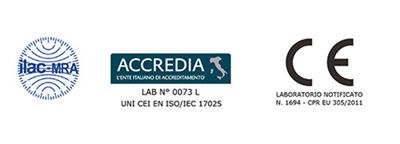Chemical composition of refractories
 Thanks to its wide range of analytical instruments, Stazione Sperimentale del Vetro is capable of determining with precision and reliability both the concentrations of the main components present in refractory materials (e.g. Si, Al, C, Mg, Zr, Cr, etc), and their possible content of trace contaminants.
Thanks to its wide range of analytical instruments, Stazione Sperimentale del Vetro is capable of determining with precision and reliability both the concentrations of the main components present in refractory materials (e.g. Si, Al, C, Mg, Zr, Cr, etc), and their possible content of trace contaminants.
Specially developed instrumental calibrations and sample preparation techniques allow the accurate analysis of acid, neutral and basic refractory matrices, including carbides, nitrides and refractories with a high Mg, Cr or Zr content.
By means of this type of analysis it is possible to determine the abundance in the sample of the most common elements (e.g. Si, Al, Na, K, Mg, Ca, Fe, Ti, Pb, Zr, Cr, etc.), expressed as weight percentage of oxides; the limit of quantification of the instrument varies between 0.001% and 0.01% depending on the specific element.
The analysis is carried out on glass discs called “beads”, which are prepared from the original sample by fine grinding, pre-calcination at a suitable temperature (to determine the loss on ingnition, LOI, of the material) and subsequent melting with alkaline flux (lithium tetraborate). If the sample type requires it (e.g. refractories containing carbides or nitrides), it is also possible to carry out the analysis without melting, using discs made of compressed powders (with wax as binder).
When the quantification of impurities or trace contaminants is required, the determination is carried out by “wet chemistry” techniques, using instruments such as GF-AAS, ICP-OES or ICP-MS, depending on the specific element to be analyzed and to the limit of detection or quantification to be achieved. Detection limits of the order of 0.1, or even 0.01 ppb for some elements, can be achieved e.g. by using the ICP-MS.
In the case of special products, such as carbide-based refractories, graphite matrices, etc, the accurate determination of the chemical composition is possible through the integrated use of different analytical techniques such as XRF + LOI, XRD and ELTRA (for total C content).
 Thanks to its wide range of analytical instruments, Stazione Sperimentale del Vetro is capable of determining with precision and reliability both the concentrations of the main components present in refractory materials (e.g. Si, Al, C, Mg, Zr, Cr, etc), and their possible content of trace contaminants.
Thanks to its wide range of analytical instruments, Stazione Sperimentale del Vetro is capable of determining with precision and reliability both the concentrations of the main components present in refractory materials (e.g. Si, Al, C, Mg, Zr, Cr, etc), and their possible content of trace contaminants.
